Слайд 1С.Сейфуллин атындағы қазақ агротехникалық университеті
Тақырыбы : Horse breed
Тексерген: Карабаева.Ж.Е
Орындаған :
Асқырбай Нұрзат Мақсатұлы
Шеңгелбай Дархан
Жақсылық Бауыржан
2018
Слайд 2
The horse (Equus ferus caballus)[2][3] is one of two extant subspecies of Equus ferus. It is an odd-toed ungulate mammal belonging
to the taxonomic family Equidae. The horse has evolved over the past 45 to 55 million years from a small multi-toed creature, Eohippus, into the large, single-toed animal of today. Humans began to domesticate horses around 4000 BC, and their domestication is believed to have been widespread by 3000 BC. Horses in the subspecies caballus are domesticated, although some domesticated populations live in the wild as feral horses. These feral populations are not true wild horses, as this term is used to describe horses that have never been domesticated, such as the endangered Przewalski's horse, a separate subspecies, and the only remaining true wild horse. There is an extensive, specialized vocabulary used to describe equine-related concepts, covering everything from anatomy to life stages, size, colors, markings, breeds, locomotion, and behavior.
Horses' anatomy enables them to make use of speed to escape predators and they have a well-developed sense of balance and a strong fight-or-flight response. Related to this need to flee from predators in the wild is an unusual trait: horses are able to sleep both standing up and lying down, with younger horses tending to sleep significantly more than adults.[4] Female horses, called mares, carry their young for approximately 11 months, and a young horse, called a foal, can stand and run shortly following birth. Most domesticated horses begin training under saddle or in harness between the ages of two and four. They reach full adult development by age five, and have an average lifespan of between 25 and 30 years.
Horse breeds are loosely divided into three categories based on general temperament: spirited "hot bloods" with speed and endurance; "cold bloods", such as draft horses and some ponies, suitable for slow, heavy work; and "warmbloods", developed from crosses between hot bloods and cold bloods, often focusing on creating breeds for specific riding purposes, particularly in Europe. There are more than 300 breeds of horse in the world today, developed for many different uses.
![The horse (Equus ferus caballus)[2][3] is one of two extant subspecies of Equus ferus. It is an odd-toed ungulate mammal belonging to](/img/tmb/1/96096/b49d334f8e5f12ae7ba26dee1e50ef8a-800x.jpg)
Слайд 3
This page is a list of horse and pony breeds, and also includes terms for types
of horse that are not breeds but are commonly mistaken for breeds. While there is no scientifically accepted definition of the term "breed",[1] a breed is defined generally as having distinct true-breeding characteristics over a number of generations. Its members may be called "purebred". In most cases, bloodlines of horse breeds are recorded with a breed registry. The concept is somewhat flexible in horses, as open stud books are created for developing horse breeds that are not yet fully true-breeding.
Registries also are considered the authority as to whether a given breed is listed as a "horse" or a "pony". There are also a number of "color breed", sport horse, and gaited horse registries for horses with various phenotypes or other traits, which admit any animal fitting a given set of physical characteristics, even if there is little or no evidence of the trait being a true-breeding characteristic. Other recording entities or specialty organizations may recognize horses from multiple breeds, thus, for the purposes of this article, such animals are classified as a "type" rather than a "breed".
The breeds and types listed here are those that already have a Wikipedia article. For a more extensive list, see the List of all horse breeds in DAD-IS.
For additional information, see horse breed, horse breeding, and the individual articles listed below. Additional articles may be listed under Category:Horse breeds and Category:Types of horse.
List of horse breeds
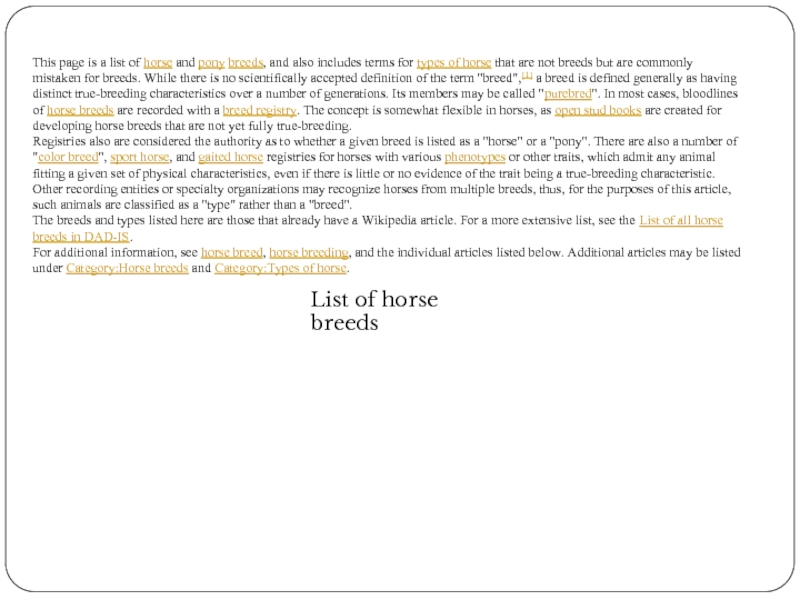
Слайд 6The Arabian or Arab horse (Arabic: الحصان العربي [ ħisˤaːn ʕarabiː], DMG ḥiṣān ʿarabī) is a breed of horse that originated on the Arabian
Peninsula. With a distinctive head shape and high tail carriage, the Arabian is one of the most easily recognizable horse breeds in the world. It is also one of the oldest breeds, with archaeological evidence of horses in the Middle East that resemble modern Arabians dating back 4,500 years. Throughout history, Arabian horses have spread around the world by both war and trade, used to improve other breeds by adding speed, refinement, endurance, and strong bone. Today, Arabian bloodlines are found in almost every modern breed of riding horse.
The Arabian developed in a desert climate and was prized by the nomadic Bedouin people, often being brought inside the family tent for shelter and protection from theft. Selective breeding for traits including an ability to form a cooperative relationship with humans created a horse breed that is good-natured, quick to learn, and willing to please. The Arabian also developed the high spirit and alertness needed in a horse used for raiding and war. This combination of willingness and sensitivity requires modern Arabian horse owners to handle their horses with competence and respect.
The Arabian is a versatile breed. Arabians dominate the discipline of endurance riding, and compete today in many other fields of equestrian sport. They are one of the top ten most popular horse breeds in the world. They are now found worldwide, including the United States and Canada, United Kingdom, Australia, continental Europe, South America (especially Brazil), and their land of origin, the Middle East.
![The Arabian or Arab horse (Arabic: الحصان العربي [ ħisˤaːn ʕarabiː], DMG ḥiṣān ʿarabī) is a breed of horse that originated on the Arabian Peninsula. With a distinctive](/img/tmb/1/96096/04b7a7f5971a4e658e4a91583e1ecefc-800x.jpg)
Слайд 8Kazakhstan presented a new breed, Adai horses, at the international arena
for the first time, Tengrinews.kz reports from Central Asian Championship on horse distance tests. Compared to splendid Arab and Akhal-Teke horses, this small horse looks quite modest. However, Kazakhstan horse breeders consider it the country's national pride as, being a novice, the horse was among the leaders even at the first international tournament it was presented at. Adai horses took the first four prizes out of 16 horses participating in the tournament, while five Adai horses took part in the contest. Altyngali Bessemagambetov who rode an eight-year-old horse named Oily won the first place. The second prize was given to Amangeldy Mukaitbayev and his 18-year-old horse Akkanat and the third prize was awarded to Kaiyrzhan Andybai on a horse named Kertobel. The international judge Aleksandr Andriyevsky could not hide his astonishment: “I am amazed, this is a big surprise for me. These small, slim and short horses of Adai breed are leading our tournament.” The horses were brought from Mangistau and Atyrau oblasts, they traveled 4.5 thousand km. Horse breeders say that this breed is used to tough living conditions. Adai horses can eat very hard grass, cover long distances and endure very hot weather of up 60 degrees Centigrade above zero. What's even more unusual is that they drink salty water from the Caspian Sea and can survive long periods of time without water. "I can easily say that Adai horses have no equals in the world. Earlier attempts were made to import Russian Don horses, fine harness horses and other pure-blooded breeds into this region, but none of them survived in herd conditions, while Adai horses did. Last year they survived dry summer and severe winter and despite that they are all safe and sound and have given birth to colts,” said the Head of horse breeding department of Kazakhstan R&D Institute of Cattle Breeding and Fodder Production Gregory Sizonov. As per the judge Aleksandr Andriyevsky, the next tournament of CIS (Commonwealth of Independent States) cup will be held in Russia close to Ryazan in the end of July 2011. Kazakhstan team has been invited to take part.
For more information see: https://en.tengrinews.kz/environment/Adai-horses-win-the-race-1755/
Use of the Tengrinews English materials must be accompanied by a hyperlink to en.Tengrinews.kz
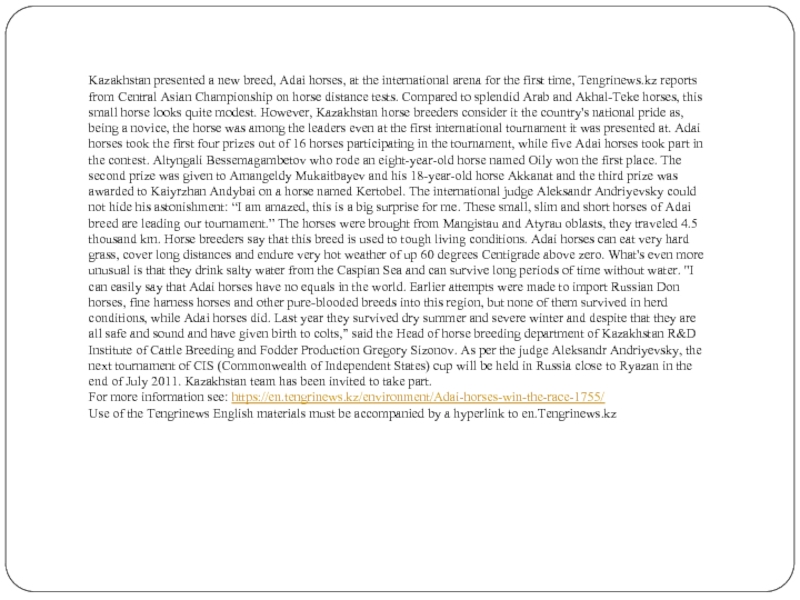
Слайд 11Horses and humans interact in a wide variety of sport competitions
and non-competitive recreational pursuits, as well as in working activities such as police work, agriculture, entertainment, and therapy. Horses were historically used in warfare, from which a wide variety of riding and driving techniques developed, using many different styles of equipment and methods of control. Many products are derived from horses, including meat, milk, hide, hair, bone, and pharmaceuticals extracted from the urine of pregnant mares. Humans provide domesticated horses with food, water and shelter, as well as attention from specialists such as veterinarians and farriers.
Слайд 12Biology
Main article: Equine anatomy
Points of a horse[5][6]
Specific terms and specialized language
are used to describe equine anatomy, different life stages, colors and breeds.
Lifespan and life stages
Depending on breed, management and environment, the modern domestic horse has a life expectancy of 25 to 30 years.[7] Uncommonly, a few animals live into their 40s and, occasionally, beyond.[8] The oldest verifiable record was "Old Billy", a 19th-century horse that lived to the age of 62.[7] In modern times, Sugar Puff, who had been listed in Guinness World Records as the world's oldest living pony, died in 2007 at age 56.[9]
Regardless of a horse or pony's actual birth date, for most competition purposes a year is added to its age each January 1 of each year in the Northern Hemisphere[7][10] and each August 1 in the Southern Hemisphere.[11] The exception is in endurance riding, where the minimum age to compete is based on the animal's actual calendar age.[12]
The following terminology is used to describe horses of various ages:
Colt: A male horse under the age of four.[13] A common terminology error is to call any young horse a "colt", when the term actually only refers to young male horses.[14]
Filly: A female horse under the age of four.[15]
Foal: A horse of either sex less than one year old. A nursing foal is sometimes called a suckling and a foal that has been weaned is called a weanling.[15] Most domesticated foals are weaned at five to seven months of age, although foals can be weaned at four months with no adverse physical effects.[16]
Gelding: A castrated male horse of any age.[15]
Mare: A female horse four years old and older.[17]
Stallion: A non-castrated male horse four years old and older.[18] The term "horse" is sometimes used colloquially to refer specifically to a stallion.[19]
Yearling: A horse of either sex that is between one and two years old.[20]
In horse racing, these definitions may differ: For example, in the British Isles, Thoroughbred horse racing defines colts and fillies as
![BiologyMain article: Equine anatomy Points of a horse[5][6]Specific terms and specialized language are used to describe equine](/img/tmb/1/96096/13f9878db7e15fc16e461f1782b8b3b6-800x.jpg)
Слайд 13Anatomy
Main articles: Equine anatomy, Muscular system of the horse, Respiratory system of the horse,
and Circulatory system of the horse
Skeletal system
Main article: Skeletal system of the horse
The skeletal system of a modern horse
The horse skeleton averages 205 bones.[59] A significant difference between the horse skeleton and that of a human is the lack of a collarbone—the horse's forelimbs are attached to the spinal column by a powerful set of muscles, tendons, and ligaments that attach the shoulder blade to the torso. The horse's legs and hooves are also unique structures. Their leg bones are proportioned differently from those of a human. For example, the body part that is called a horse's "knee" is actually made up of the carpal bones that correspond to the human wrist. Similarly, the hock contains bones equivalent to those in the human ankle and heel. The lower leg bones of a horse correspond to the bones of the human hand or foot, and the fetlock (incorrectly called the "ankle") is actually the proximal sesamoid bones between the cannon bones (a single equivalent to the human metacarpal or metatarsal bones) and the proximal phalanges, located where one finds the "knuckles" of a human. A horse also has no muscles in its legs below the knees and hocks, only skin, hair, bone, tendons, ligaments, cartilage, and the assorted specialized tissues that make up the hoof.[60]
Hooves
Main articles: Horse hoof, Horseshoe, and Farrier
The critical importance of the feet and legs is summed up by the traditional adage, "no foot, no horse".[61] The horse hoof begins with the distal phalanges, the equivalent of the human fingertip or tip of the toe, surrounded by cartilage and other specialized, blood-rich soft tissues such as the laminae. The exterior hoof wall and horn of the sole is made of keratin, the same material as a human fingernail.[62] The end result is that a horse, weighing on average 500 kilograms (1,100 lb),[63] travels on the same bones as would a human on tiptoe.[64] For the protection of the hoof under certain conditions, some horses have horseshoes placed on their feet by a professional farrier. The hoof continually grows, and in most domesticated horses needs to be trimmed (and horseshoes reset, if used) every five to eight weeks,[65] though the hooves of horses in the wild wear down and regrow at a rate suitable for their terrain.
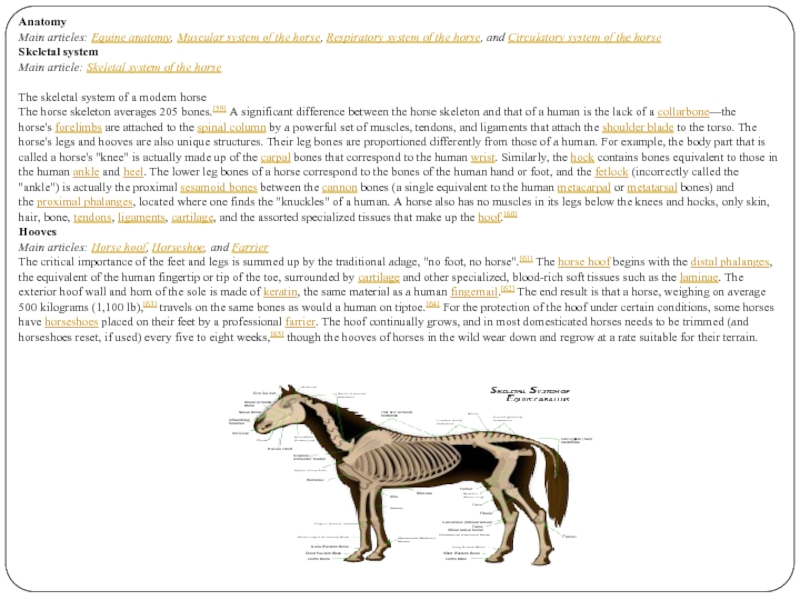
Слайд 14Taxonomy and evolution
From left to right: Size development, biometrical changes
in the cranium, reduction of toes (left forefoot)
Main articles: Evolution of the horse, Equus (genus), and Equidae
The horse adapted to survive in areas of wide-open terrain with sparse vegetation, surviving in an ecosystem where other large grazing animals, especially ruminants, could not.[118] Horses and other equids are odd-toed ungulates of the order Perissodactyla, a group of mammals that was dominant during the Tertiary period. In the past, this order contained 14 families, but only three—Equidae (the horse and related species), Tapiridae (the tapir), and Rhinocerotidae (the rhinoceroses)—have survived to the present day.[119]
The earliest known member of the family Equidae was the Hyracotherium, which lived between 45 and 55 million years ago, during the Eocene period. It had 4 toes on each front foot, and 3 toes on each back foot.[120] The extra toe on the front feet soon disappeared with the Mesohippus, which lived 32 to 37 million years ago.[121] Over time, the extra side toes shrank in size until they vanished. All that remains of them in modern horses is a set of small vestigial bones on the leg below the knee,[122] known informally as splint bones.[123] Their legs also lengthened as their toes disappeared until they were a hooved animal capable of running at great speed.[122] By about 5 million years ago, the modern Equus had evolved.[124] Equid teeth also evolved from browsing on soft, tropical plants to adapt to browsing of drier plant material, then to grazing of tougher plains grasses. Thus proto-horses changed from leaf-eating forest-dwellers to grass-eating inhabitants of semi-arid regions worldwide, including the steppes of Eurasia and the Great Plains of North America.
By about 15,000 years ago, Equus ferus was a widespread holarctic species. Horse bones from this time period, the late Pleistocene, are found in Europe, Eurasia, Beringia, and North America.[125] Yet between 10,000 and 7,600 years ago, the horse became extinct in North America and rare elsewhere.[126][127][128] The reasons for this extinction are not fully known, but one theory notes that extinction in North America paralleled human arrival.[129] Another theory points to climate change, noting that approximately 12,500 years ago, the grasses characteristic of a steppe ecosystem gave way to shrub tundra, which was covered with unpalatable plants.[130]
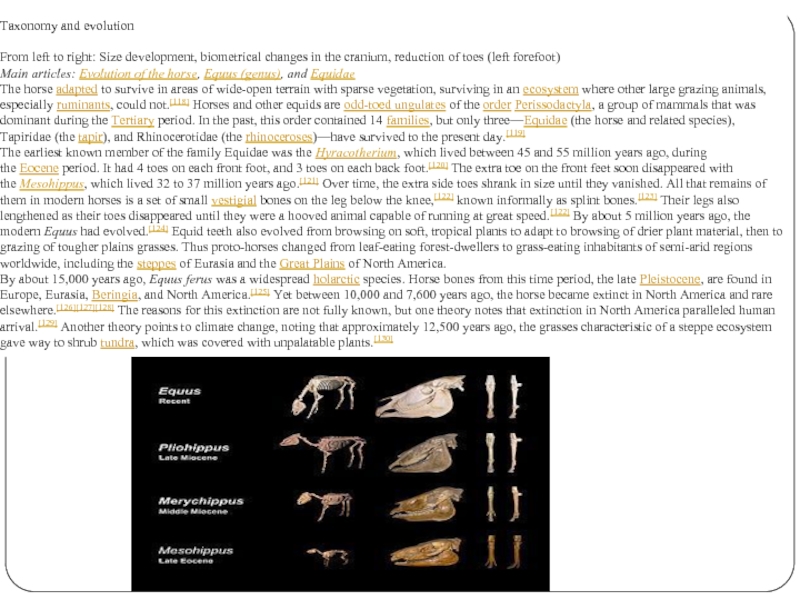
Слайд 15Sport
A horse and rider in dressage competition at the Olympics
Main articles: Equestrianism, Horse racing, Horse training,
and Horse tack
Historically, equestrians honed their skills through games and races. Equestrian sports provided entertainment for crowds and honed the excellent horsemanship that was needed in battle. Many sports, such as dressage, eventing and show jumping, have origins in military training, which were focused on control and balance of both horse and rider. Other sports, such as rodeo, developed from practical skills such as those needed on working ranches and stations. Sport hunting from horseback evolved from earlier practical hunting techniques.[177] Horse racing of all types evolved from impromptu competitions between riders or drivers. All forms of competition, requiring demanding and specialized skills from both horse and rider, resulted in the systematic development of specialized breeds and equipment for each sport. The popularity of equestrian sports through the centuries has resulted in the preservation of skills that would otherwise have disappeared after horses stopped being used in combat.[177]
Horses are trained to be ridden or driven in a variety of sporting competitions. Examples include show jumping, dressage, three-day eventing, competitive driving, endurance riding, gymkhana, rodeos, and fox hunting.[182]Horse shows, which have their origins in medieval European fairs, are held around the world. They host a huge range of classes, covering all of the mounted and harness disciplines, as well as "In-hand" classes where the horses are led, rather than ridden, to be evaluated on their conformation. The method of judging varies with the discipline, but winning usually depends on style and ability of both horse and rider.[183] Sports such as polo do not judge the horse itself, but rather use the horse as a partner for human competitors as a necessary part of the game. Although the horse requires specialized training to participate, the details of its performance are not judged, only the result of the rider's actions—be it getting a ball through a goal or some other task.[184] Examples of these sports of partnership between human and horse include jousting, in which the main goal is for one rider to unseat the other,[185] and buzkashi, a team game played throughout Central Asia, the aim being to capture a goat carcass while on horseback.[184]
Horse racing is an equestrian sport and major international industry, watched in almost every nation of the world. There are three types: "flat" racing; steeplechasing, i.e. racing over jumps; and harness racing, where horses

Слайд 16Work
A mounted police officer in Poland
There are certain jobs that
horses do very well, and no technology has yet developed to fully replace them. For example, mounted police horses are still effective for certain types of patrol duties and crowd control.[188] Cattle ranches still require riders on horseback to round up cattle that are scattered across remote, rugged terrain.[189] Search and rescue organizations in some countries depend upon mounted teams to locate people, particularly hikers and children, and to provide disaster relief assistance.[190] Horses can also be used in areas where it is necessary to avoid vehicular disruption to delicate soil, such as nature reserves. They may also be the only form of transport allowed in wilderness areas. Horses are quieter than motorized vehicles. Law enforcement officers such as park rangers or game wardens may use horses for patrols, and horses or mules may also be used for clearing trails or other work in areas of rough terrain where vehicles are less effective.[191]
Tanga (carriage) at Darbhanga Bihar
Although machinery has replaced horses in many parts of the world, an estimated 100 million horses, donkeys and mules are still used for agriculture and transportation in less developed areas. This number includes around 27 million working animals in Africa alone.[192] Some land management practices such as cultivating and logging can be efficiently performed with horses. In agriculture, less fossil fuel is used and increased environmental conservation occurs over time with the use of draft animals such as horses.[193][194] Logging with horses can result in reduced damage to soil structure and less damage to trees due to more selective logging.[195]
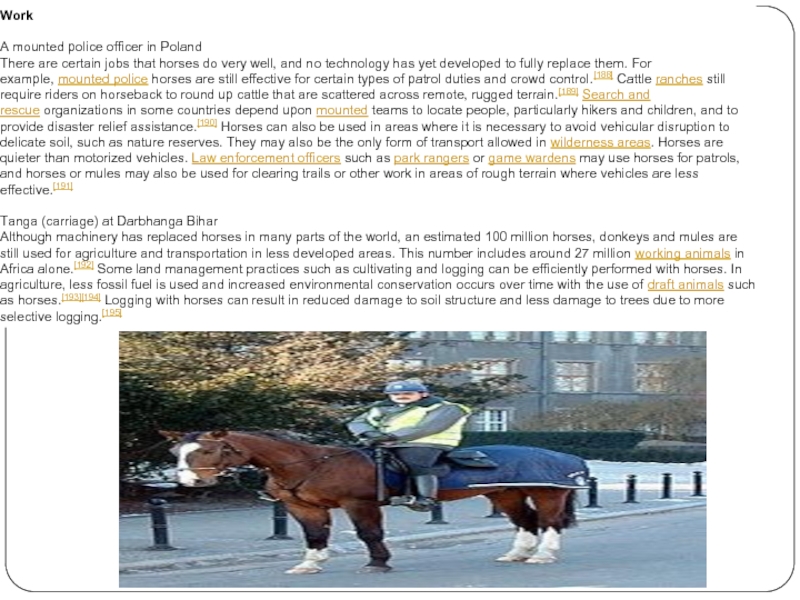
Слайд 17Care
Main article: Horse care
See also: Equine nutrition, Horse grooming, Veterinary medicine, and Farrier
Checking teeth and
other physical examinations are an important part of horse care.
Horses are grazing animals, and their major source of nutrients is good-quality forage from hay or pasture.[224] They can consume approximately 2% to 2.5% of their body weight in dry feed each day. Therefore, a 450-kilogram (990 lb) adult horse could eat up to 11 kilograms (24 lb) of food.[225] Sometimes, concentrated feed such as grain is fed in addition to pasture or hay, especially when the animal is very active.[226] When grain is fed, equine nutritionists recommend that 50% or more of the animal's diet by weight should still be forage.[227]
Horses require a plentiful supply of clean water, a minimum of 10 US gallons (38 L) to 12 US gallons (45 L) per day.[228] Although horses are adapted to live outside, they require shelter from the wind and precipitation, which can range from a simple shed or shelter to an elaborate stable.[229]
Horses require routine hoof care from a farrier, as well as vaccinations to protect against various diseases, and dental examinations from a veterinarian or a specialized equine dentist.[230] If horses are kept inside in a barn, they require regular daily exercise for their physical health and mental well-being.[231] When turned outside, they require well-maintained, sturdy fences to be safely contained.[232] Regular grooming is also helpful to help the horse maintain good health of the hair coat and underlying skin.[233]
